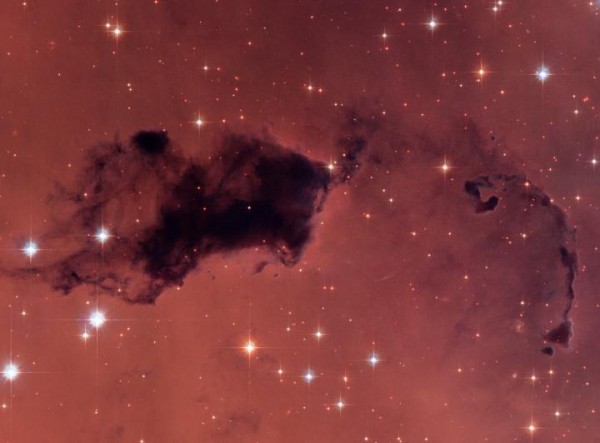Water is Already Abundant in the Universe After the Big Bang
| Ana Verayo | | Apr 29, 2015 07:12 AM EDT |
(Photo : NASA, ESA, and The Hubble Heritage Team) This Hubble image features dark knots of gas and dust known as "Bok globules," which are dense pockets in larger molecular clouds. Similar islands of material in the early universe could have held as much water vapor as we find in our galaxy today, despite containing a thousand times less oxygen.
Astronomers have studied ancient molecular clouds in the Milky Way galaxy that reveal that the existence of water in the universe came to be much earlier that previously thought, some one billion years after the Big Bang event.
However, the basic elements of water formations is composed of two hydrogen atoms and one oxygen atom which are elements heavier than helium that are thought to first formed inisde stars and not during the Big Bang.
Like Us on Facebook
The first generation of stars where thought to have formed longer than regular stars and even longer to become mature and die meaning heavy elements such as oxygen would have formed from stellar winds and supernovae much more later.
Since the basic elements of water molecules will have taken some time to form, astronomers thought that for oxygen to disperse throughout space and then attach itself to hydrogen happened much later in the universe's timeline.
However, this new study claims that the abundance of water occured only a billion years after the universe's first light came to be.
According to Avi Loeb from the Harvard-Smithsonian Center for Astrophysics, researchers analyzed the chemistry of young molecular clouds that contains a thosuand times less oxygen than the sun, surprisingly, water vapor is as abundant as in our galaxy.
The first generation of stars appeared some 100 million years after the Big Bang and were massive giants and highly unstable. These stars rapidly burnt out their hydrogen fuel and exploding into supernovae. These cosmic interstellar explosions gave birth to heavier elements in the universe that made pockets of gas that are rich in elements but poor in oxygen.
However, even if these gas clouds were low in oxygen, this became the perfect environment for the birth of water molecules possessing temperatures of 80 degrees Fahrenheit that enabled oxygen atoms to combine with abundant hydrogen in the gas clouds.
According to Shmuel Bialy from Tel Aviv University, these temperatures were highly likely since the universe was warmer compared to today and the gas clouds were unable to cool down.
This new study reveals that even if the universe was relatively young, it had emitted enough elements to nurture an environment abundant with water even when gas clouds are depleted of oxygen. This unusual set of circumstances encouraged the formation of planets where water is already present.
This study is published in the journal Astrophysical Journal Letters.
Tagswater in the universe, Big Bang, water first appeared in the universe, water universe first one billion years, Milky Way
©2015 Chinatopix All rights reserved. Do not reproduce without permission
EDITOR'S PICKS
-

Did the Trump administration just announce plans for a trade war with ‘hostile’ China and Russia?
-

US Senate passes Taiwan travel bill slammed by China
-

As Yan Sihong’s family grieves, here are other Chinese students who went missing abroad. Some have never been found
-

Beijing blasts Western critics who ‘smear China’ with the term sharp power
-

China Envoy Seeks to Defuse Tensions With U.S. as a Trade War Brews
-

Singapore's Deputy PM Provides Bitcoin Vote of Confidence Amid China's Blanket Bans
-

China warns investors over risks in overseas virtual currency trading
-

Chinese government most trustworthy: survey
-

Kashima Antlers On Course For Back-To-Back Titles
MOST POPULAR
LATEST NEWS
Zhou Yongkang: China's Former Security Chief Sentenced to Life in Prison

China's former Chief of the Ministry of Public Security, Zhou Yongkang, has been given a life sentence after he was found guilty of abusing his office, bribery and deliberately ... Full Article
TRENDING STORY

China Pork Prices Expected to Stabilize As The Supplies Recover

Elephone P9000 Smartphone is now on Sale on Amazon India

There's a Big Chance Cliffhangers Won't Still Be Resolved When Grey's Anatomy Season 13 Returns

Supreme Court Ruled on Samsung vs Apple Dispute for Patent Infringement

Microsoft Surface Pro 5 Rumors and Release Date: What is the Latest?










